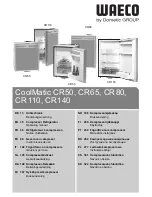
Storage of foods
Instructions for storing foods
CAUTION
Energy saving tips
When storing freezing foods, put them to the inside of freezing
chamber, other than the bottle rack.
Do not put bottled or canned foods into the freezing chamber to
prevent frost cracking.
Before putting hot foods into the refrigerator, cool them to room
temperature first; otherwise, they will increase power consumption.
Mark the freezing date on the packaging bag according to different
storage lives of foods, so as to prevent foods from exceeding the
time limit.
Divide foods into proper pieces and package them separately, which
are easy to freeze thoroughly and will not frozen together.
The packaging materials shall be odorless, airtight, watertight and
pollution-free, so packaged foods are not easy to taint by other odor,
without quality reduction.
Do not put too many fresh foods into the freezing chamber once,
preferably not exceeding the freezing capacity value of refrigerator.
Melted foods can not be frozen again, unless they are made into
dishes; otherwise, their service quality will be affected.
Glass bottles or glass containers shall not be placed into the freezing
chamber or at the air outlet of refrigerating chamber duct; otherwise,
they may explode.
Foods can not block the air outlet; otherwise, abnormal air circulation
will be caused.
Make sure to keep the refrigerator away from heat source and direct
sunlight.
Before storing hot foods, cool them to room temperature and then
put into refrigerator.
Close the door timely, reduce the opening frequency, and shorten
the opening time.
When unfreezing frozen foods, you can put them into the
refrigerating chamber, which will assist in refrigeration of the
refrigerating chamber.
Make sure that the temperature sensor is not covered or blocked by
foods, and keep proper distance with foods.
Operation
18




































